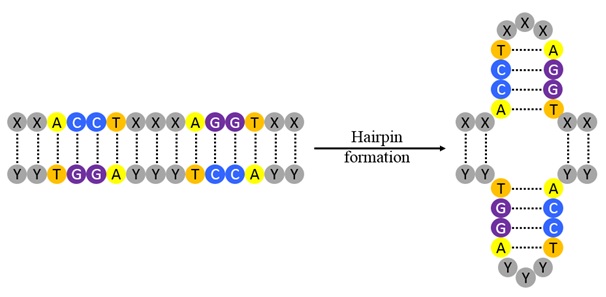 A palindrome reads the same backwards as forwards, from the Greek παλίνδρομος, recurring or running back again, a compound of παλίν, back, and δρόμος, a course or racetrack. Other words that start with palin- include palingenesis (regeneration, rebirth, revival, resuscitation), palinode (originally an ode or song in which the poet retracted a view or sentiment expressed in a former composition; later recantation, retraction, or withdrawal of a statement), and palintocia (repayment of interest, literally rebirth). A palimpsest is a paper or parchment that can be re-used after the original writing has been rubbed off. Other words ending in -drome include aerodrome, hippodrome, loxodrome (an imaginary line on the earth’s surface used to plot a ship’s course), peridrome (a gallery, a colonnaded porch or arcade), and syndrome.
A palindrome reads the same backwards as forwards, from the Greek παλίνδρομος, recurring or running back again, a compound of παλίν, back, and δρόμος, a course or racetrack. Other words that start with palin- include palingenesis (regeneration, rebirth, revival, resuscitation), palinode (originally an ode or song in which the poet retracted a view or sentiment expressed in a former composition; later recantation, retraction, or withdrawal of a statement), and palintocia (repayment of interest, literally rebirth). A palimpsest is a paper or parchment that can be re-used after the original writing has been rubbed off. Other words ending in -drome include aerodrome, hippodrome, loxodrome (an imaginary line on the earth’s surface used to plot a ship’s course), peridrome (a gallery, a colonnaded porch or arcade), and syndrome.
Palindromes can be single words—did, deed, dewed, deified—or sentences; “a man, a plan, a canal, Panama” celebrates the inspiration of the diplomat Ferdinand de Lesseps. “So patient a doctor to doctor a patient so” is a word by word palindrome. Palindromic business names include Skoob Books in London and the Yreka Bakery in Yreka, California.
The longest one word palindrome that I have found in any printed dictionary is “Malayalam”, a Dravidian language, related to Tamil, spoken in Kerala and adjacent parts of southwest India. “Semitimes”, equally long, was used by Henry More in Apocalypsis Apocalypseos (1680): “The things foretold . . . are not to terminate on a year, but rather require that grosser numbring [sic] by Semitimes”; a semitime is half a year. “Detartrated” is longer, and may be justified by “tartrated”, which is to be found in Webster’s Third New International Dictionary. Tartrated antimony is better known as tartar emetic.
Palindromes are found in many languages. For example, the Greek sentence Νίψον ἀνομήματα μὴ μόναν ὄψιν, wash my sins, not only my face, was inscribed on a font outside the church of Agia Sophia in Constantinople and elsewhere. The Latin palindrome “acide me malo, sed non desola me, medica” means “cut me to the quick, doctor, but don’t leave me”.
Palindromic numbers may seem trivial, but take any number below 10 000 (except 196), reverse it, add it to itself, and repeat. For example, 59 + 95 = 154; 154 + 451 = 605; 605 + 506 = 1111, a palindrome. Now try it with 1111. Or calculate 7986442 or 22013.
A semordnilap is a word that forms a different word when read backwards. Long examples found in the OED include redrawer, samaroid, and stressed.
Musical palindromes are usually semordnilaps. In the first movement of Bartok’s 5th string quartet each section of exposition is given in reverse order during the recapitulation. In dodecaphonic music the tone row can be used forwards, backwards, and both ways inverted. Stravinsky’s setting of Edward Lear’s poem “The Owl and the Pussycat” is an example.
Palindromic rheumatism is a form of arthritis in which there are recurrent attacks of sudden onset without any precipitating event and without residual joint damage. Attacks last up to 48 hours, occasionally longer, and mainly affect the wrists and the small joints of the hands, followed by the knees, shoulders, and ankles. It keeps on coming back.
Palindromes occur in DNA, but they are defined differently. Each of the four nucleotides (bases) in DNA has a matching complementary base on the partner strand in the double helix: adenine (A) and thymine (T) are complementary, as are cytosine (C) and guanine (G).
A nucleotide sequence is said to be palindromic if it is equal to the reverse of its complementary sequence. For example, the sequence of bases GATTACATGTAATC (a sequence I have chosen for fans of the movie) is palindromic, because its complementary sequence is the semordnilap CTAATGTACATTAG. The musical analogy of a DNA palindrome is a crab canon (canon cancrizans), in which a line is played forwards and then backwards, or both simultaneously (Figure 1).

A pseudopalindromic sequence is one with an odd number of base pairs that are symmetrical at front and back. For example, the DNA sequence ACCTTAGGT is pseudopalindromic, because its complement is TGGAATCCA. Palindromic sequences like this can form hairpins (Figure 2). This allows repairs to be carried out when damage occurs. Many restriction endonucleases recognise specific palindromic sequences and act at those sites, giving bacteria a defence against bacteriophages. Turning them back, you might say.

Jeffrey Aronson is a clinical pharmacologist, working in the Centre for Evidence Based Medicine in Oxford’s Nuffield Department of Primary Care Health Sciences. He is also president emeritus of the British Pharmacological Society.
Competing interests: None declared.
